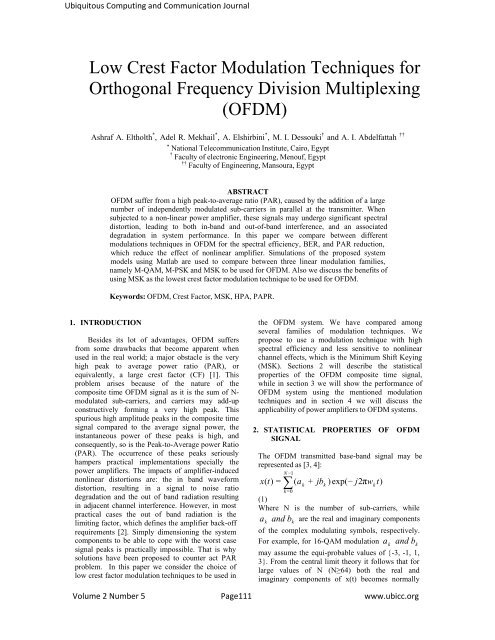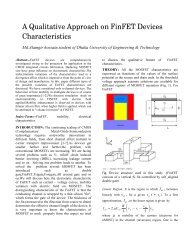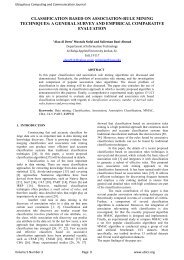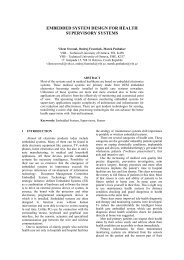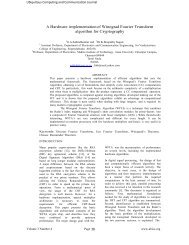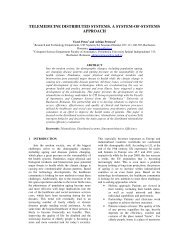Low Crest Factor Modulation Techniques for Orthogonal Frequency ...
Low Crest Factor Modulation Techniques for Orthogonal Frequency ...
Low Crest Factor Modulation Techniques for Orthogonal Frequency ...
You also want an ePaper? Increase the reach of your titles
YUMPU automatically turns print PDFs into web optimized ePapers that Google loves.
Ubiquitous Computing and Communication Journal<br />
<strong>Low</strong> <strong>Crest</strong> <strong>Factor</strong> <strong>Modulation</strong> <strong>Techniques</strong> <strong>for</strong><br />
<strong>Orthogonal</strong> <strong>Frequency</strong> Division Multiplexing<br />
(OFDM)<br />
Ashraf A. Eltholth * , Adel R. Mekhail * , A. Elshirbini * , M. I. Dessouki † and A. I. Abdelfattah ††<br />
*<br />
National Telecommunication Institute, Cairo, Egypt<br />
†<br />
Faculty of electronic Engineering, Menouf, Egypt<br />
††<br />
Faculty of Engineering, Mansoura, Egypt<br />
ABSTRACT<br />
OFDM suffer from a high peak-to-average ratio (PAR), caused by the addition of a large<br />
number of independently modulated sub-carriers in parallel at the transmitter. When<br />
subjected to a non-linear power amplifier, these signals may undergo significant spectral<br />
distortion, leading to both in-band and out-of-band interference, and an associated<br />
degradation in system per<strong>for</strong>mance. In this paper we compare between different<br />
modulations techniques in OFDM <strong>for</strong> the spectral efficiency, BER, and PAR reduction,<br />
which reduce the effect of nonlinear amplifier. Simulations of the proposed system<br />
models using Matlab are used to compare between three linear modulation families,<br />
namely M-QAM, M-PSK and MSK to be used <strong>for</strong> OFDM. Also we discuss the benefits of<br />
using MSK as the lowest crest factor modulation technique to be used <strong>for</strong> OFDM.<br />
Keywords: OFDM, <strong>Crest</strong> <strong>Factor</strong>, MSK, HPA, PAPR.<br />
1. INTRODUCTION<br />
Besides its lot of advantages, OFDM suffers<br />
from some drawbacks that become apparent when<br />
used in the real world; a major obstacle is the very<br />
high peak to average power ratio (PAR), or<br />
equivalently, a large crest factor (CF) [1]. This<br />
problem arises because of the nature of the<br />
composite time OFDM signal as it is the sum of N-<br />
modulated sub-carriers, and carriers may add-up<br />
constructively <strong>for</strong>ming a very high peak. This<br />
spurious high amplitude peaks in the composite time<br />
signal compared to the average signal power, the<br />
instantaneous power of these peaks is high, and<br />
consequently, so is the Peak-to-Average power Ratio<br />
(PAR). The occurrence of these peaks seriously<br />
hampers practical implementations specially the<br />
power amplifiers. The impacts of amplifier-induced<br />
nonlinear distortions are: the in band wave<strong>for</strong>m<br />
distortion, resulting in a signal to noise ratio<br />
degradation and the out of band radiation resulting<br />
in adjacent channel interference. However, in most<br />
practical cases the out of band radiation is the<br />
limiting factor, which defines the amplifier back-off<br />
requirements [2]. Simply dimensioning the system<br />
the OFDM system. We have compared among<br />
several families of modulation techniques. We<br />
propose to use a modulation technique with high<br />
spectral efficiency and less sensitive to nonlinear<br />
channel effects, which is the Minimum Shift Keying<br />
(MSK). Sections 2 will describe the statistical<br />
properties of the OFDM composite time signal,<br />
while in section 3 we will show the per<strong>for</strong>mance of<br />
OFDM system using the mentioned modulation<br />
techniques and in section 4 we will discuss the<br />
applicability of power amplifiers to OFDM systems.<br />
2. STATISTICAL PROPERTIES OF OFDM<br />
SIGNAL<br />
The OFDM transmitted base-band signal may be<br />
represented as [3, 4]:<br />
N −1<br />
x(t ) = ∑ (a k<br />
+ jb k<br />
) exp(− j 2πw k<br />
t )<br />
Volume 2 Number 5 Page 111 www.ubicc.org<br />
k =0<br />
(1)<br />
Where N is the number of sub-carriers, while<br />
a k and b k<br />
are the real and imaginary components<br />
of the complex modulating symbols, respectively.<br />
components to be able to cope with the worst case For example, <strong>for</strong> 16-QAM modulation a k<br />
and b k<br />
signal peaks is practically impossible. That is why<br />
may assume the equi-probable values of {-3, -1, 1,<br />
solutions have been proposed to counter act PAR<br />
3}. From the central limit theory it follows that <strong>for</strong><br />
problem. In this paper we consider the choice of<br />
large values of N (N≥64) both the real and<br />
low crest factor modulation techniques to be used in<br />
imaginary components of x(t) becomes normally
Ubiquitous Computing and Communication Journal<br />
distributed variable having a mean of zero. And<br />
thus, the absolute value will have Rayleigh<br />
distribution.<br />
The crest factor of the discrete time representation<br />
x(k) is defined as the ratio of the peak magnitude<br />
value and the square root of the average power of<br />
this signal. For the OFDM signal as we mentioned it<br />
have a zero mean and thus the square root of the<br />
average power will be equal to the standard<br />
deviation δ. Thus the crest factor can be written as:<br />
CF = max(x(k )) = max(x(k )) (2)<br />
E ( x 2 ) δ<br />
Note that, the peak to average power ratio, widely<br />
used in literature, is simply the square of the crest<br />
factor. Both quantities coincide, if expressed in<br />
logarithmic scale (dB).<br />
An OFDM system is simulated using Matlab with<br />
512 sub-carriers; We have per<strong>for</strong>med a measure of<br />
normality, i.e., wither the composite time signal<br />
approaches the normal distribution or not, as a<br />
verification of the applicability of central limit<br />
theory to OFDM, and we get the following result as<br />
shown in figure (1)<br />
It can be noticed that the real and imaginary parts of<br />
the OFDM signal completely agree with the normal<br />
distribution.<br />
a. The minimum Euclidean distance amongst<br />
phasors, which is characteristics of the noise<br />
immunity of the scheme<br />
b. The minimum phase rotation amongst<br />
constellation points, determining the phase jitter<br />
immunity<br />
c. The peak to average phasor power, which is a<br />
measure of robustness against non-linear distortion<br />
introduced by power amplifiers.<br />
Fig.(2) Block diagram of OFDM system<br />
Probability<br />
0.999<br />
0.997<br />
0.99<br />
0.98<br />
0.95<br />
0.90<br />
0.75<br />
0.50<br />
0.25<br />
0.10<br />
0.05<br />
0.02<br />
0.01<br />
0.003<br />
0.001<br />
Normal Probability Plot<br />
The Bandwidth efficiency can be increased either by<br />
increasing the Number of signal phase levels, or by<br />
increasing the Number of signal amplitude levels<br />
[6],<br />
1. Increasing the signal amplitude levels has the<br />
drawback that the signal envelope is not constant<br />
and there<strong>for</strong>e non-linear amplification may cause<br />
spreading of the signal spectrum and increase in<br />
BER.<br />
2. Increasing the Number of phase levels will<br />
highly increase the BER.<br />
-0.5 -0.4 -0.3 -0.2 -0.1 0 0.1 0.2 0.3 0.4<br />
Data<br />
Fig.(1) Normal probability plot of OFDM signal<br />
3. OFDM USING DIFFERENT MODULATORS<br />
In this section we will simulate an OFDM system<br />
as shown in the block diagram in figure (2) using<br />
different modulation techniques.<br />
We have simulated an OFDM system with different<br />
modulation techniques, namely, M-ary PSK, M-ary<br />
QAM (with M=4, 8, 16 and 32) and Minimum Shift<br />
Keying (MSK).<br />
When designing a constellation diagram <strong>for</strong> a<br />
modulation technique, some considerations must be<br />
given to [5]:<br />
Fig.(3)OFDM Spectrum with different modulation<br />
We have noted that <strong>for</strong> M-PSK, as M increases no<br />
effect has been occurred to the dynamic range and<br />
the PAR remains nearly the same, while <strong>for</strong> M-<br />
QAM, as M increases the dynamic range increase<br />
and so the PAR, but both of them agree in the<br />
Volume 2 Number 5 Page 112 www.ubicc.org
Ubiquitous Computing and Communication Journal<br />
spectral efficiency increase as M increase. This is<br />
shown in figure 3.<br />
It is also noticeable from figure (3) that the<br />
Bandwidth of MSK is nearly the same as that of<br />
QPSK, but with lower power.<br />
Dens ity<br />
ranges in [-4δ, 4δ], this can be a good indicator <strong>for</strong><br />
clipping efficiency.<br />
BER BER<br />
0<br />
10<br />
When analyzing the statistical properties of the -2<br />
10<br />
OFDM composite time signal we deduced the<br />
following: As shown in figure (4); The probability<br />
density function of the absolute OFDM signal agrees -4<br />
10<br />
with the Rayleigh distribution <strong>for</strong> all used<br />
modulation techniques.<br />
0.167<br />
1<br />
-6<br />
pdf of absolute values of OFDM signal 10<br />
16-QAM<br />
0 32-QAM<br />
4,16,32-PSK<br />
8-PSK<br />
8-QAM<br />
16-QAM<br />
16-PSK<br />
-8<br />
10<br />
0 2 4 6 8 10 12 14 16 18<br />
/N (dB)<br />
0.83<br />
E b 0<br />
0.67<br />
0.5<br />
0.33<br />
0.167<br />
0<br />
-4<br />
10<br />
0 0.2 0.4 0.6 0.8 1 1.2 1.4 1.6<br />
Data<br />
Fig.(4) PDF of OFDM with different modulation<br />
And in agreement with figure (3), as M-increases in<br />
M-QAM the dynamic range increases, and in the<br />
case of MSK the dynamic range is less than that of<br />
QPSK.<br />
Table I. Shows PAR, standard deviation δ and the<br />
dynamic range of the OFDM signal with the above<br />
mentioned modulation techniques<br />
MOD<br />
TABLE I.<br />
PAR AND STD OF OFDM SIGNAL<br />
PAR<br />
(dB)<br />
STD (δ)<br />
Absolute signal range<br />
MSK 8.3902 0.0427 0.0642<br />
QPSK 8.7001 0.0562 0.0912≡ MSK + 3 dB<br />
8QAM 9.0063 0.0965 0.1470≡ QPSK +4 dB<br />
16QAM 9.2989 0.1247 0.2213≡ 8QAM +3.5 dB<br />
32QAM 10.082 0.1777 0.2780≡ 16QAM +2 dB<br />
It is again in agreement with the above results. It<br />
is clear that although the PAR reduction due to the<br />
use of MSK instead of QPSK is slightly small, the<br />
true gain is the reduction in the dynamic range by 3<br />
dB, which enables us to use a low linearity and high<br />
efficiency power amplifiers. In addition a new<br />
indicator arises in the table which is the standard<br />
deviation δ, it is obvious from the table that MSK has<br />
the lowest δ while <strong>for</strong> M-QAM, as M increase δ<br />
increases also, since we can deal with OFDM signal<br />
as a narrow band Gaussian noise with a mean of zero<br />
and variance of δ 2 , then 68% of amplitude values<br />
ranges in [-δ,δ] and 99.994% of amplitude values<br />
Fig.(5-a)BER of OFDM using 8,16 -PSK&QAM<br />
0<br />
10<br />
10 -2<br />
-6<br />
10<br />
32-QAM<br />
32-PSK<br />
64-QAM<br />
-8<br />
10<br />
0 2 4 6 8 10 12 14 16 18<br />
E /N (dB)<br />
b 0<br />
Fig.(5-b) BER of OFDM using 32,64 -PSK&QAM<br />
Regarding to the BER per<strong>for</strong>mance of the used<br />
modulation techniques, it is clear from figure (5-a )<br />
and (5-b) that, <strong>for</strong> M-PSK and M-QAM, the BER<br />
increases ad M increase while <strong>for</strong> the same M the<br />
BER of M-PSK is larger than that of M-QAM <strong>for</strong><br />
the same E b /N o .<br />
4. THE EFFECT OF POWER AMPLIFIERS<br />
Due to the nature of OFDM signal generation,<br />
as we mentioned above, signals have large crest<br />
factor CF, which set a demand <strong>for</strong> linearity. PAs are<br />
divided into classes according to the biasing used,<br />
the most common used amplifier classes are A, B<br />
and C.<br />
Class A amplifiers are the most linear among all<br />
classes, but with the lowest efficiency (50% at<br />
maximum). This poor efficiency causes high power<br />
consumption, which leads to worming in physical<br />
devices, and short battery life <strong>for</strong> mobile users. To<br />
achieve a better efficiency class B or C amplifiers<br />
are used but this costs a worse linearity. The high<br />
demands on linearity make class B or C unsuitable<br />
<strong>for</strong> OFDM systems. In practical applications of<br />
OFDM using QAM modulators, the amplifier is a<br />
compromise between class A and B, it is called class<br />
AB amplifier. NLA Model used <strong>for</strong> OFDM system<br />
is Rapp’s SSPA with characteristic [7]:<br />
Volume 2 Number 5 Page 113 www.ubicc.org
Ubiquitous Computing and Communication Journal<br />
v out<br />
=<br />
and hence facilitates the utilization of power<br />
v in<br />
efficient class C amplifier [6].<br />
1<br />
QPSK<br />
0<br />
10<br />
(1 + ( v in<br />
/ v sat ) 2 p ) 2 p<br />
Where v out and v in<br />
are complex i/p & o/p of the<br />
HPA , v sat<br />
is the output saturation level (we use<br />
v sat<br />
= 0.2, 0.5, 0.8 and 1) and P is “knee factor” that<br />
controls the smoothness of characteristic curve (we<br />
use P=2)<br />
1<br />
0.9<br />
0.8<br />
0.7<br />
0.6<br />
Vsat=0.5<br />
Vsat=0.8<br />
Vsat=0.2<br />
Vsat=1<br />
Volume 2 Number 5 Page 114 www.ubicc.org<br />
-1<br />
10<br />
-2<br />
10<br />
-3<br />
10<br />
QPSK without NLA<br />
QPSK with NLA<br />
10 -4 16-QAM with NLA<br />
16-QAM without NLA<br />
8-QAMwithout NLA<br />
8-QAM with NLA<br />
0.5 5. CONCLUSIONS<br />
0.4<br />
-5<br />
10<br />
0 2 4 6 8 10 12 14 16 18 20<br />
Figure (7-b) effect of NLA on M-QAM<br />
For M-PSK, as M increases no effect has been<br />
0.3<br />
0.2<br />
0.1<br />
0<br />
0 0.2 0.4 0.6 0.8 1 1.2 1.4 1.6 1.8 2<br />
occurred to the dynamic range and the PAR remains<br />
nearly the same, while <strong>for</strong> M-QAM, as M increases<br />
the dynamic range increase and so the PAR, but both<br />
of them agree in the spectral efficiency increase as<br />
M increase.<br />
Figure (6) NLA input/output characteristic For M-PSK and M-QAM, the BER increases as M<br />
Figure (6) shows the Input output characteristics of increase while <strong>for</strong> the same M the BER of M-PSK is<br />
the amplifier with the above specified parameters. larger than that of M-QAM <strong>for</strong> the same E b /N o .<br />
When applying this amplifier using v sat<br />
= 0.1 on the<br />
Although the PAR reduction due to the use of MSK<br />
instead of QPSK is slightly small, the true gain is the<br />
OFDM signal we have noticed the advantage of reduction in the dynamic range by 3 dB, which<br />
MSK over QPSK, as shown below in figure (7-a). enables us to use a low linearity and high efficiency<br />
Also we have applied the amplifier on the OFDM power amplifiers like class B or C.<br />
signal using M-QAM with M=4, 8 and 16. Using MSK modulation gives us the lowest <strong>Crest</strong> <strong>Factor</strong><br />
v sat<br />
= 0.2, we noticed that as M increases the when used in OFDM besides its main advantage,<br />
-1<br />
10<br />
-2<br />
10<br />
-3<br />
10<br />
-4<br />
10<br />
distortion due to NLA increases and so the BER as<br />
shown in figure (7-b).<br />
MSK without NLA<br />
MSK with NLA<br />
QPSK with NLA<br />
QPSK without NLA<br />
-5<br />
10<br />
1 2 3 4 5 6 7 8 9 10<br />
Figure (7-a) effect of NLA on MSK & QPSK<br />
As regarding to our previous results, it can be<br />
noticed that, the MSK modulation gives us the<br />
lowest PAR when used in OFDM besides its main<br />
advantage, that it ignores any fading introduced<br />
amplitude fluctuation present in the received signal,<br />
that it ignores any fading introduced amplitude<br />
fluctuation present in the received signal, and hence<br />
facilitates the utilization of power efficient class C<br />
amplifier.<br />
REFERENCES<br />
[1] Hanzo,” Bandwidth efficient wireless multimedia<br />
communications”, Proc. of IEEE, Vol.86, No.7, July 1998.<br />
[2] J. Akhtman, B.Z. Bobrovsky, L.Hanzo,”Peak-to-average<br />
Power Ration reduction <strong>for</strong> OFDM Modems”, Proc. of<br />
VTC’2003, Jeju, Korea, 2003<br />
[3] K. R. Panta, J. Armstrong,” Use of Peak-to- average power<br />
reduction technique in HIPERLAN2 and its per<strong>for</strong>mance in<br />
fading channel”,DSPCS’02, Australia, Jan.2002.<br />
[4] Farzaneh Kohandani,” PAR reduction in OFDM/CDMA<br />
Systems”, E&CE 612 Project, April 2002.<br />
[5] L. Hanzo, W. Webb, T. Keller,“ Single and Multi-carrier<br />
Qudrature Amplitude <strong>Modulation</strong>”, NY, John Wiley sons,<br />
LTD, 2000.<br />
[6] T. Javornik, G. Kandus, and A.G. Burr, “The per<strong>for</strong>mance<br />
of N-GMSK signals in non-linear channels”, WMPC'01,<br />
Aalborg, September 2001.<br />
[7] A. Saul,” Comparison between Recursive Clipping and<br />
Active Constellation Extension <strong>for</strong> Peak Reduction in<br />
OFDM Systems”, in Proc. of Int. Symp. on Wireless<br />
Personal Multimedia Communications, Vol. 1, Yokusuka,<br />
Japan, October 19-22, 2003. © 2003 WPMC


